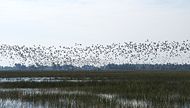COP23: The last cranes of Cambodia

Sarus cranes rely on wetlands and marshes to survive - but they face a deluge of problems. Not only is climate change drying out their natural habitat, but dwindling fish stocks and pesticides from surrounding rice fields are endangering their already vulnerable existence. January has traditionally been a time when flocks of this rare bird gather in the Lower Mekong Basin, along the border between Cambodia and Vietnam. These days, however, there are only 1,000 sarus cranes left in the region, which has led the Cambodian government to declare some areas as conservation zones. To make sure local communities don't use the land for agricultural purposes, the International Climate Initiative is teaching them how to protect against increasingly hard rainfall, move away from using pesticides, and irrigate more efficiently.
A film by Christian Jaburg
The link has been copied to the clipboard
Information
Length
2:37 Minutes
Date of publication
2017
Project
Climate change adaptation through climate-sensitive flood water management in the Lower Mekong Basin
Global Ideas



